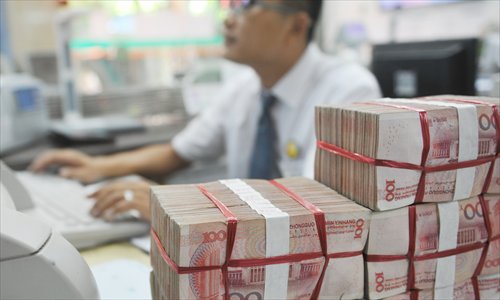
A bank staff member handles yuan transaction in Qionghai, South China's Hainan Province. Photo: CFP
The Chinese yuan has now become the fifth most traded currency in terms of global foreign exchange turnover, with a market share of seven percent, according to a report issued by the Bank of International Settlements (BIS) on Friday. The new ranking of Chinese yuan was up from the eighth place in the 2019 survey, underscoring the attractiveness of the Chinese currency amid a push for global de-dollarization and a global investors' consensus on the bright prospects of the world's second-largest economy.
According to the report which titled "triennial central bank survey of foreign exchange and over-the-counter (OTC) derivatives markets in 2022," trading in OTC FX markets reached $7.5 trillion per day in April 2022, up 14 percent from $6.6 trillion three years earlier, setting a new record high. The data collection coincided with "heightened FX volatility due to changing expectations about the path of future interest rates in major advanced economies, rising commodity prices and geopolitical tensions" following the Russia-Ukraine conflicts.
Among which, the Chinese yuan exhibited the biggest increase in market share since the 2019 survey, being on one side of seven percent of all trades in 2022, up from four percent in 2019. The US dollar remains the world's most used trading currency, with an 88 percent market share, unchanged from the previous survey. Euros continued to be the world's second most traded currency, with a share of 30.5 percent, down from 32 percent in 2019. The Japanese yen and pounds were ranked third and fourth with a share of 17 percent and 13 percent of all trades, respectively, virtually unchanged since the 2019 survey.
The statistics published in BIS' report were collated in April and involved central banks and other authorities in 52 jurisdictions
"The yuan's elevation in the share of global FX market is a positive sign, mirroring that yuan's globalization push has achieved remarkable steps," Hu Qimu, chief research fellow at the Sinosteel Economic Research Institute, told the Global Times on Friday.
As Fed's interest rate hikes lead to sharp currency depreciation of both advanced and developing economies, countries have been actively seeking for alternative currencies to hedge against the financial risks. Against such a backdrop, Chinese yuan, which saw its value deprecation relatively "moderate" compared with other currencies of major economies such as pound and euro, has risen to become the trade settlement and foreign exchange reserves of more countries, according to Hu.
Since the beginning of the year, China has either signed or extended currency swap deals with a number of countries and regions such as Russia and Europe, contributing to the yuan's growing share in the global market, observers said.
According to a report issued by IMF in September, the Chinese yuan accounted for 2.88 percent of global foreign currency reserves in the second quarter of 2022, ranking fifth worldwide and maintaining its highest global reading since data was first released in 2016.
"The yuan's expansion in global market also reflects the global confidence on the outlook of Chinese economy, which is underpinned by its position as the world's largest trading nation, its sound economic fundamentals and sheer market size," Hu said.




